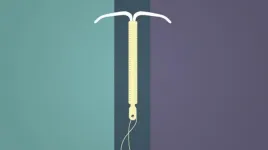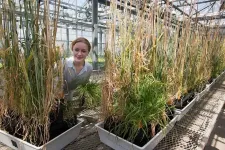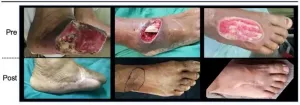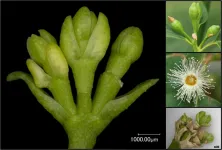Myositis-specific autoreactive T cells are pathogenic for dermatomyositis
Researchers from the University of Tsukuba discover how autoimmunity against a ubiquitous autoantigen triggers idiopathic inflammatory myopathies
2021-04-07
(Press-News.org) Tsukuba, Japan - Dermatomyositis is an idiopathic inflammatory myopathy that has been regarded as an autoimmunity-based disorder, although its pathogenesis remains unclear. In this study, researchers from the University of Tsukuba used a mouse model to identify a mechanism by which dermatomyositis may develop in humans. The animal model and findings can be used to better understand the disease and develop disease-specific treatments.
Dermatomyositis belongs to a group of idiopathic inflammatory myopathies that are associated with the presence of specific autoantibodies in patient sera. Multiple myositis-specific autoantibodies, which target proteins ubiquitously expressed in the nucleus or cytoplasm, have been described. One of these autoantibodies is specific for transcriptional intermediary factor 1γ (TIF1γ).
"Autoimmune diseases constitute a difficult challenge for patients and doctors," says lead author of the study, Professor Naoko Okiyama. "Not only are the diagnosis and treatment of autoimmune diseases clinically difficult, but it is often unclear why and how the diseases developed. In this study, we investigated the role of a specific autoantibody present in the sera of patients with dermatomyositis, the anti-TIF1γ antibody, in the pathogenesis of the disease."
To achieve their goal, the researchers injected TIF1γ protein into normal mice, as well as several mouse models lacking proteins that play distinct roles in the body's immune response. The researchers' aim was to determine which part of the immune system contributes to the development of dermatomyositis. In normal mice, injection of TIF1γ resulted in the production of TIF1γ-specific T cells and anti-TIF1γ autoantibodies, thereby inducing myositis. In this myositis, CD8+ T cell infiltration into muscle cells resulted in muscle fiber wasting. Generally, CD8+ T cells are important for eliminating infected cells, cancer cells, and other damaged cells.
Importantly, the disease severity was significantly reduced when TIF1γ was injected into mice that lacked the ability to present antigens to CD8+ T cells. Adoptive transfer of CD8+ T cells, but not antibodies, collected from TIF1γ-treated mice led to myositis in recipient mice. This suggests that autoreactive CD8+ T cells against TIF1γ contribute to the pathogenesis of dermatomyositis, while autoantibodies against TIF1γ are simply non-pathogenic clinical diagnostic markers.
"In contrast to existing animal models of experimental myositis, which use muscle-specific antigens, our results show that autoreactive T cell-mediated autoimmunity to TIF1γ may play a causal role in dermatomyositis. This new experimental model may be a new tool to further investigate the disease and develop new therapeutics against dermatomyositis," says Professor Okiyama.
INFORMATION:
The article, "Immune response to dermatomyositis-specific autoantigen, transcriptional intermediary factor 1γ, can result in experimental myositis" has been published in Annals of the Rheumatic Diseases at DOI 10.1136/annrheumdis-2020-218661.
ELSE PRESS RELEASES FROM THIS DATE:
2021-04-07
A team of scientists led by Nanyang Technological University, Singapore (NTU Singapore) has created a reusable, biodegradable sponge that can readily soak up oil and other organic solvents from contaminated water sources, making it a promising alternative for tackling marine oil spills.
Made of sunflower pollen, the sponge is hydrophobic - it repels water - thanks to a coat of natural fatty acid on the sponge. In lab experiments, the scientists showed the sponge's ability to absorb oil contaminants of various densities, such as gasoline and motor oil, ...
2021-04-07
Astronomers have found two close pairs of quasars in the distant Universe. Follow-up observations with Gemini North spectroscopically resolved one of the distant quasar pairs, after their discovery with the Hubble Space Telescope and Gaia spacecraft. These quasars are closer together than any pair of quasars found so far away, providing strong evidence for the existence of supermassive black hole pairs as well as crucial insight into galaxy mergers in the early Universe.
The quasars in each of the two pairs are separated by just over 10,000 light-years, suggesting ...
2021-04-07
Getting a birth control implant used to cost some women hundreds of dollars, if they were among the nearly half of privately insured Americans covered by a health plan with a high deductible that they were responsible for paying.
But a new study in the April issue of Health Affairs shows that after the Affordable Care Act's no-cost birth control provision took effect in 2013, women in these high-deductible health plans (HDHPs) opted for long-acting contraception even more than women with other types of health plans.
The study's findings have important policy implications, because employers now have the ability to opt out of the birth control portion of the ACA, following a Supreme Court case decided in 2020. Many employers have shifted to HDHPs to hold down their overall health ...
2021-04-07
Stem rust is a devastating disease of cereal crops, including barley, one of the first domesticated crops in agriculture and the fourth most widely grown crop in the world. Barley is unique because it is one of only a few crops that can be cultivated in almost any climate and across a range of elevations, making it economically and nutritionally important.
Stem rust is one of the biggest threats to barley production and capable of causing complete crop loss during severe epidemics. And since barley is also used as malt for beer and spirits and feed for animals ...
2021-04-07
Thirty years ago, clinical psychiatrist Jonathan Shay drew attention to similarities between the trauma experienced by the Greek warriors, as documented in the epic poem "The Iliad," and Vietnam veterans in America. Could the experience of war impact people in similar ways in vastly different cultural milieus?
Research published this week by ASU researcher Sarah Mathew and former ASU postdoctoral researcher Matthew Zefferman in the Proceedings of the National Academy of Sciences shows that Turkana pastoralist warriors from Kenya also experience PTSD (post-traumatic stress disorder) symptoms, even though their lifestyles and combat experiences are ...
2021-04-07
Direct human alterations to natural aquatic ecosystems can increase methane emissions, a new study has found.
Atmospheric methane has tripled since pre-industrial times. It traps heat far more effectively than carbon dioxide and accounts for 25% of atmospheric warming to date. And much of that methane is coming from aquatic ecosystems, with human activities contributing to the emissions levels, a new paper published in Nature Geoscience has found.
The global contribution and importance of aquatic ecosystems as methane emitters has been underestimated, ...
2021-04-07
Anyone who has visited the Australian outback would be familiar with spinifex grasses, which cover almost a fifth of our continent.
Like many scientists, they may have also wondered why this iconic arid grass grows in striking ring shapes.
Previous studies have tested whether spinifex rings could be caused by termites, water availability or nutrient depletion, but none has provided a convincing explanation.
Now scientists from UNSW Sydney have found that pathogenic soil microbes play a role in how the spinifex got its hole.
Their study, the first of its kind in an arid ecosystem, has been published in the Australian Journal of Botany.
Professor Angela Moles and Neil Ross from ...
2021-04-07
Durham, NC - According to the results of a phase 1 clinical trial just published in STEM CELLS Translational Medicine, a new stem cell therapy shows promise of making diabetes-related amputations a thing of the past. The trial involved injecting diabetes patients suffering from non-healing diabetic foot ulcers (DFU) with a cell preparation containing adult stem cells harvested from their own fat. The results showed that the treatment induced regeneration of the blood vessels surrounding the DFUs, accelerated healing - all with no serious side effects.
"Non-healing diabetic foot ulcers usually ...
2021-04-07
CORVALLIS, Ore. - Eucalyptus, a pest-resistant evergreen valued for its hardy lumber and wellness-promoting oil, can be genetically modified not to reproduce sexually, a key step toward preventing the global tree plantation staple from invading native ecosystems.
Oregon State University's Steve Strauss led an international collaboration that showed the CRISPR Cas9 gene editing technique could be used with nearly 100% efficiency to knock out LEAFY, the master gene behind flower formation.
"The flowers never developed to the point where ovules, pollen or ...
2021-04-07
Two thirds of New Zealanders believed there were 'silver linings' to the country's Alert Level 4 COVID-19 lockdown imposed in March last year, a University of Otago survey has found.
The researchers were able to question New Zealanders while they were at home, giving a unique insight into their lives during the nationwide lockdown between 25 March and 23 April, widely regarded as one of the strictest imposed anywhere in the world.
One year on from lockdown, the results of their study have been published in the international scientific journal, PLOS ONE.
Participants were asked 'Have you experienced any silver linings, or positive aspects during the COVID-19 Level 4 lockdown' and were able to answer 'yes, for me personally', ...
LAST 30 PRESS RELEASES:
[Press-News.org] Myositis-specific autoreactive T cells are pathogenic for dermatomyositis
Researchers from the University of Tsukuba discover how autoimmunity against a ubiquitous autoantigen triggers idiopathic inflammatory myopathies





